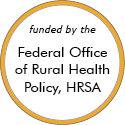Rural Project Examples: Healthcare needs and services
Promising Examples
Contingency Management Smoking Cessation in Appalachia
Updated/reviewed June 2022
- Need: To reduce smoking rates of pregnant women and adolescents in Appalachian regions of eastern Kentucky and Ohio.
- Intervention: A web-based smoking cessation program that offered monetary incentives to reduce smoking.
- Results: Participants significantly reduced smoking rates or quit altogether.
School-Based Health Center Dental Outreach

Updated/reviewed July 2020
- Need: To improve the oral health status of children ages 3 to 17 living in rural areas of Louisiana.
- Intervention: School-based nurse practitioners perform oral health assessments, apply fluoride varnishes when indicated, and make dental referrals, with completion rates of the latter tracked by dental case managers.
- Results: Significant numbers of school children are receiving oral health examinations, fluoride varnish applications, and receiving care coordination to improve numbers of completed dental appointments.
Other Project Examples
Mind Your BEAT
Updated/reviewed January 2026
- Need: Rural cancer survivors report lower levels of physical activity and higher rates of psychosocial distress compared to their urban counterparts.
- Intervention: Researchers collaborated with a rural-serving organization in northeast Texas to test a 3-month intervention which enhanced an existing exercise program with behavioral health education, yoga, and home-based exercise components.
- Results: Program participants were twice as likely to report meeting physical activity recommendations at post-intervention than participants in a control group and reported significant reductions in psychosocial distress.
Rural Aging Action Network
Updated/reviewed January 2026
- Need: To connect isolated older adults and family caregivers in rural Minnesota, Montana, North Dakota, and South Dakota to services and supports so they can age in place.
- Intervention: The Rural Aging Action Network is a national collaborative of organizations that mobilize whole communities to address gaps in care for rural older adults and family caregivers.
- Results: Since 2022, the collaborative has reached over 1,000 older adults and over 200 family caregivers living in rural communities.
Riverfront Talks: Substance Matters Podcast
Updated/reviewed December 2025
- Need: To reduce stigma around mental illness and substance use in North Carolina.
- Intervention: The Beaufort County Behavioral Health Task Force created the Riverfront Talks: Substance Matters podcast to interview people with lived experience.
- Results: As of December 2025, the podcast has 18 episodes.
CMH Addiction Recovery Program

Updated/reviewed November 2025
- Need: To help individuals and families impacted by substance use disorder access treatment and counseling in rural Missouri.
- Intervention: The CMH Addiction Recovery Program provides medication-assisted treatment, counseling, peer and family support, and other related services within a Rural Health Clinic.
- Results: The program operates 5 days a week and sees 400 patients each month.
Men's Conversation Group
Updated/reviewed November 2025
- Need: Suicide rates among men age 65 and older have been rising in North Carolina. Challenges include losing friends, illnesses, and the loss of independence – all of which can lead to isolation and depression.
- Intervention: Chatham County Aging Services of North Carolina started the Men's Conversation Group to connect retired men in need of male friends and mutual support.
- Results: Men in similar stages of life and varying backgrounds are forming friendships, engaging in activities, and taking care of their mental health.
Mobile Integrated Healthcare Network (MIHN)

Updated/reviewed November 2025
- Need: To bring preventive care and other services to rural Missouri patients with chronic illnesses and difficulties accessing primary care.
- Intervention: Community paramedics make home visits and provide basic care, home assessments, and medication reconciliation and facilitate telehealth visits.
- Results: Patients experienced improved access to care, health status, and compliance with medication regimens along with increased patient engagement, satisfaction, and access to community resources.
One Health Recovery Doulas

Updated/reviewed November 2025
- Need: To support pregnant and parenting women with a history of substance use, mental health, or co-occurring disorders in rural areas of Montana.
- Intervention: One Health, a consortium of Federally Qualified Health Centers (FQHCs), developed a team of "recovery doulas" – individuals who are dual-certified as doulas and peer-support specialists. The One Health recovery doula program offers group and individual services to women and their partners from pregnancy through the first years of parenthood.
- Results: A team of four recovery doulas (or doulas-in-training) employed by One Health offer services in 8 rural eastern Montana counties. One Health has also successfully trained and certified 35 Peer Recovery Doulas statewide through their Peer Recovery Doula certification curriculum.
The Coffee Break Project
Updated/reviewed November 2025
- Need: Men in the agriculture industry face high suicide rates due to factors including long hours, geographic isolation, lack of social opportunities, and stigma surrounding mental health care.
- Intervention: The Coffee Break Project, a program led by Valley-Wide Health Systems, Inc. in southeastern Colorado, encourages mental health check-ins for farmers and ranchers through a public awareness campaign and casual coffee gatherings that utilize COMET, an intervention model developed specifically for rural communities.
- Results: Between eight and 20 people typically attend each coffee gathering.
For examples from other sources, see:
